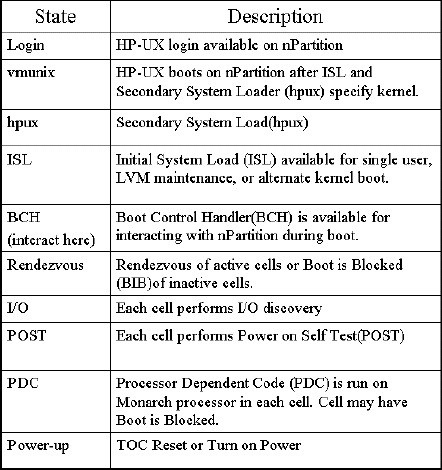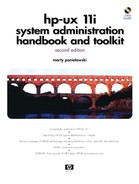The Boot Process Boot Console Handler (BCH) Commands
nPartitions boot in a similar manner to any HP 9000. Figure 17-2 shows the high-level steps involved in booting an nPartition:
Figure 17-5. Boot Steps

BCH is the primary way to interact with an nPartition at boot time, just as it is on any HP 9000. The steps and interfaces of the boot process meld together. There are a few different interfaces and levels of boot through which you work. When you get to the main menu of the Management Processor and issue commands you are using BCH. When you get past BCH, you reach ISL, which is considered the next step of the boot process beyond BCH. Then you reach the secondary system loader, which we'll see in the upcoming example by issuing the hpux command, which attempts to load the kernel. You need to know at what level of the boot process you are work ing so you can issue the appropriate commands.
When you access the console for an nPartition that is idle, you would issue the BOOT command and then stop the boot process if you wish to get an ISL> prompt or allow the nPartition to boot automatically. The BCH and boot process in general are not much different for an nPartition than they are for a much smaller system covered in Chapter 1.
The following listing shows several steps that we'll perform to boot an nPartition in the upcoming example. I'll issue a variety of commands to give you an idea of some steps you can perform during the boot process at various prompts. We'll do the following:
- Go from the Management Processor to the Command Menu with cm.
- List the default customer LAN settings of the Management Processor with ls.
- Change the customer LAN settings with lc.
- List the new LAN settings with ls.
- Go back to the main Management Processor menu with ma.
- Go to the nPartition consoles with co.
- Select nPartition 0 with 0.
- Boot from the primary boot path with bo pri.
- Specify that we want to stop at the ISL prompt.
- List ISL commands with ?.
- Proceed the boot from the primary path with hpux.
Main Menu: Enter command or menu >
GSP MAIN MENU:
CO: Consoles
VFP: Virtual Front Panel
CM: Command Menu
CL: Console Logs
SL: Show chassis Logs
HE: Help
X: Exit Connection
GSP> cm <-- Go to Command Menu
Enter HE to get a list of available commands
GSP:CM> ls <-- List customer LAN
Current configuration of GSP customer LAN interface
MAC address : 00:10:83:fd:77:f7
IP address : 192.168.1.1 0xc0a80101
Name : gsp0
Subnet mask : 255.255.255.0 0xffffff00
Gateway : 192.168.1.1 0xc0a80101
Status : UP and RUNNING
Current configuration of GSP private LAN interface
MAC address : 00:a0:f0:00:ce:1f
IP address : 192.168.2.11 0xc0a8020b
Name : priv-01
Subnet mask : 255.255.255.0 0xffffff00
Gateway : 192.168.2.11 0xc0a8020b
Status : UP and RUNNING
GSP:CM> lc <-- Modify customer LAN
This command modifies the LAN parameters.
Current configuration of GSP customer LAN interface
MAC address : 00:10:83:fd:77:f7
IP address : 192.168.1.1 0xc0a80101
Name : gsp0
Subnet mask : 255.255.255.0 0xffffff00
Gateway : 192.168.1.1 0xc0a80101
Status : UP and RUNNING
Do you want to modify the configuration for the customer LAN? (Y/[N]) y
Current IP Address is: 192.168.1.1
Do you want to modify it? (Y/[N]) y
Enter new IP Address: 157.235.10.249
New IP Address will be: 157.235.10.249
Please confirm (Y/[N]) y
-> IP Address will be updated.
Current GSP Network Name is: gsp0
Do you want to modify it? (Y/[N]) n
Current Subnet Mask is: 255.255.255.0
Do you want to modify it? (Y/[N]) n
Current Gateway is: 192.168.1.1
Do you want to modify it? (Y/[N]) (Default will be IP address.) 157.235.10.2
46y
Current Gateway is: 192.168.1.1
Do you want to modify it? (Y/[N]) (Default will be IP address.) y
Enter new Gateway: 157.235.10.246
New Gateway will be: 157.235.10.246
Please confirm (Y/[N]) y
-> Gateway will be updated.
Current configuration of GSP private LAN interface
MAC address : 00:a0:f0:00:ce:1f
IP address : 192.168.2.11 0xc0a8020b
Name : priv-01
Subnet mask : 255.255.255.0 0xffffff00
Gateway : 192.168.2.11 0xc0a8020b
Status : UP and RUNNING
Do you want to modify the configuration for the private LAN? (Y/[N]) n
-> Parameters have been updated.
GSP:CM> ls <-- List new LAN attributes
Current configuration of GSP customer LAN interface
MAC address : 00:10:83:fd:77:f7
IP address : 157.235.10.249 0x9deb0af9
Name : gsp0
Subnet mask : 255.255.255.0 0xffffff00
Gateway : 157.235.10.246 0x9deb0af6
Status : UP and RUNNING
Current configuration of GSP private LAN interface
MAC address : 00:a0:f0:00:ce:1f
IP address : 192.168.2.11 0xc0a8020b
Name : priv-01
Subnet mask : 255.255.255.0 0xffffff00
Gateway : 192.168.2.11 0xc0a8020b
Status : UP and RUNNING
GSP:CM> ma <-- Go back to MAIN Menu
GSP:CM>
GSP MAIN MENU:
CO: Consoles
VFP: Virtual Front Panel
CM: Command Menu
CL: Console Logs
SL: Show chassis Logs
HE: Help
X: Exit Connection
GSP> co <-- Go to Consoles
Partitions available:
# Name
--- ----
0) asap60
Q) Quit
Please select partition number: 0
<-- Select nPartition 0
Connecting to Console: asap60
(Use ^B to return to main menu.)
[A few lines of context from the console log:]
- - - - - - - - - - - - - - - - - - - - - - - - - - - - - - -
SERvice menu Displays service commands
DIsplay Redisplay the current menu
HElp [<menu>|<command>] Display help for menu or command
REBOOT Restart Partition
RECONFIGRESET Reset to allow Reconfig Complex Profile
Main Menu: Enter command or menu >
- - - - - - - - - - - - - - - - - - - - - - - - - - - - - - -
Main Menu: Enter command or menu > bo pri <-- Boot from pri path
Primary Boot Path: 0/0/1/0/0.0
Do you wish to stop at the ISL prompt prior to booting? (y/n) >> y
^-- Stop at ISL
Initializing boot Device.
Boot IO Dependent Code (IODC) Revision 0
Boot Path Initialized.
HARD Booted.
ISL Revision A.00.43 Apr 12, 2000
ISL> ? <-- List ISL commands
HELP Help Facility
LS List ISL utilities
AUTOBOOT Set or clear autoboot flag in stable storage
AUTOSEARCH Set or clear autosearch flag in stable storage
PRIMPATH Modify primary boot path in stable storage
ALTPATH Modify alternate boot path in stable storage
CONSPATH Modify system console path in stable storage
DISPLAY Display boot and console paths in stable storage
LSAUTOFL List contents of autoboot file
FASTSIZE Sets or displays FASTSIZE
800SUPPORT Boots the s800 Support Kernel from the boot device
700SUPPORT Boot the s700 Support Kernel from the boot device
READNVM Displays contents of one word of NVM
READSS Displays contents of one word of stable storage
LSBATCH List contents of batch file
BATCH Execute commands in batch file
LSEST List contents of EST (Extended Self Test) file
EST Execute commands in EST (Extended Self Test) file
EXIT Return to the Boot Console Handler
Enter 'LS' to see a list of the ISL utilities.
ISL> hpux <-- Proceed to boot from pri
Boot
: disk(0/0/1/0/0.0.0.0.0.0.0;0)/stand/vmunix
9814016 + 1875968 + 1340312 start 0x1f4b68
gate64: sysvec_vaddr = 0xc0002000 for 2 pages
NOTICE: nfs3_link(): File system was registered at index 4.
NOTICE: autofs_link(): File system was registered at index 6.
NOTICE: cachefs_link(): File system was registered at index 7.
td: claimed Tachyon TL/TS Fibre Channel Mass Storage card at 0/0/2/0/0
td: claimed Tachyon TL/TS Fibre Channel Mass Storage card at 0/0/3/0/0
td: claimed Tachyon TL/TS Fibre Channel Mass Storage card at 0/0/10/0/0
td: claimed Tachyon TL/TS Fibre Channel Mass Storage card at 2/0/2/0/0
td: claimed Tachyon TL/TS Fibre Channel Mass Storage card at 2/0/3/0/0
td: claimed Tachyon TL/TS Fibre Channel Mass Storage card at 2/0/10/0/0
System Console is on the Built-In Serial Interface
Entering cifs_init...
Initialization finished successfully... slot is 9
Logical volume 64, 0x3 configured as ROOT
Logical volume 64, 0x2 configured as SWAP
Logical volume 64, 0x2 configured as DUMP
Logical volume 64, 0xa configured as DUMP
Swap device table: (start & size given in 512-byte blocks)
entry 0 - major is 64, minor is 0x2; start = 0, size = 8388608
Starting the STREAMS daemons-phase 1
Checking root file system.
file system is clean - log replay is not required
Root check done.
Create STCP device files
Starting the STREAMS daemons-phase 2
$Revision: vmunix: vw: -proj selectors: CUPI80_BL2000_1108 -c 'Vw
for CUPI80_BL2000_1108 build' -- cupi80_bl2000_1108 'CUPI80_BL2000_1108' Wed No
v 8 19:24:56 PST 2000 $
Memory Information:
physical page size = 4096 bytes, logical page size = 4096 bytes
Physical: 16760832 Kbytes, lockable: 13462944 Kbytes, available: 15450828 Kb
ytes
/sbin/ioinitrc:
/sbin/krs_sysinit:
/sbin/bcheckrc:
Checking for LVM volume groups and Activating (if any exist)
Volume group "/dev/vg00" has been successfully changed.
Resynchronized volume group /dev/vg00
vxfs fsck: sanity check: root file system OK (mounted read/write)
Checking hfs file systems
/sbin/fsclean: /dev/vg00/lvol1 (mounted) ok
HFS file systems are OK, not running fsck
Checking vxfs file systems
/dev/vg00/lvol8 :
vxfs fsck: sanity check: /dev/vg00/lvol8 OK
/dev/vg00/lvol9 :
vxfs fsck: sanity check: /dev/vg00/lvol9 OK
/dev/vg00/lvol3 :
vxfs fsck: sanity check: root file system OK (mounted read/write)
/dev/vg00/lvol4 :
vxfs fsck: sanity check: /dev/vg00/lvol4 OK
/dev/vg00/lvol5 :
vxfs fsck: sanity check: /dev/vg00/lvol5 OK
/dev/vg00/lvol6 :
vxfs fsck: sanity check: /dev/vg00/lvol6 OK
/dev/vg00/lvol7 :
vxfs fsck: sanity check: /dev/vg00/lvol7 OK
Cleaning /etc/ptmp...
(c)Copyright 1983-2000 Hewlett-Packard Co., All Rights Reserved.
(c)Copyright 1979, 1980, 1983, 1985-1993 The Regents of the Univ. of California
(c)Copyright 1980, 1984, 1986 Novell, Inc.
(c)Copyright 1986-1992 Sun Microsystems, Inc.
(c)Copyright 1985, 1986, 1988 Massachusetts Institute of Technology
(c)Copyright 1989-1993 The Open Software Foundation, Inc.
(c)Copyright 1986 Digital Equipment Corp.
(c)Copyright 1990 Motorola, Inc.
(c)Copyright 1990, 1991, 1992 Cornell University
(c)Copyright 1989-1991 The University of Maryland
(c)Copyright 1988 Carnegie Mellon University
(c)Copyright 1991-2000 Mentat Inc.
(c)Copyright 1996 Morning Star Technologies, Inc.
(c)Copyright 1996 Progressive Systems, Inc.
(c)Copyright 1991-2000 Isogon Corporation, All Rights Reserved.
RESTRICTED RIGHTS LEGEND
Use, duplication, or disclosure by the U.S. Government is subject to
restrictions as set forth in sub-paragraph (c)(1)(ii) of the Rights in
Technical Data and Computer Software clause in DFARS 252.227-7013.
Hewlett-Packard Company
3000 Hanover Street
Palo Alto, CA 94304 U.S.A.
Rights for non-DOD U.S. Government Departments and Agencies are as set
forth in FAR 52.227-19(c)(1,2).
/sbin/auto_parms: DHCP access is disabled (see /etc/auto_parms.log)
HP-UX Start-up in progress
__________________________
<-- All startup programs run and Login prompt provided
The system is ready.
GenericSysName [HP Release B.11.11] (see /etc/issue)
Console Login:
We have only scratched the surface of BCH and other boot-related commands in this example and section. Knowing where you are in the boot process and the commands available to you is important in working with nPartitions, so that you can perform functions on the nPartition on which you're working or the complex in general.
